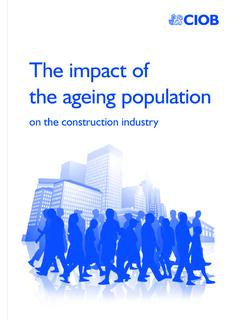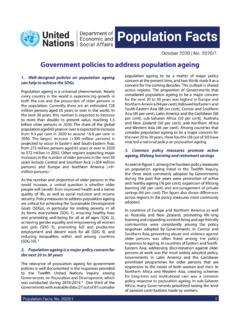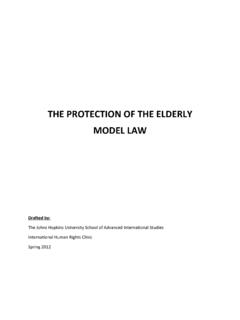Transcription of Ageing Well - GOV.UK
1 A Compendium of Factsheets: Wellbeing Across the Lifecourse Ageing well . - Although advancing age is associated with physical and cognitive decline, wellbeing is consistently found to be higher in later life than among young or middle aged adults, however it subsequently is found to decline in the oldest old - Affective, eudemonic and evaluative wellbeing all predict future subjective health, suggesting that impaired wellbeing is not just a product of poor health, but it is also systematically associated with the development of poor health - The influence of social relationships on the risk of death are comparable to other established mortality risk factors such as smoking and alcohol consumption, and actually exceed the influence of physical activity and obesity - Survival over an average of more than nine years was associated with greater enjoyment of life.
2 Effects were large, with the risk of dying being around three times greater among individuals in the lowest (compared with the highest) third of enjoyment of life 1. Wellbeing in an Ageing population The UK population is Ageing . The oldest old' are the fastest growing sector in society; one in six people are currently over 65, and it is estimated that by 2033, nearly a quarter of the population will be 65 and over 1. Ageing well is thus important, particularly in relation to cost of health care and sustainability of health budgets. The absence of physical disease and disability are common criteria for successful Ageing , however when older people are asked what successful Ageing is, they say things like contentment with life, being socially connected, and able to pursue their interests 2.
3 A paradox of Ageing has been observed in later life: although advancing age is associated with physical and cognitive decline, wellbeing is consistently found to be higher in later life than among young or middle aged adults2. This has been observed for the evaluative, affect and eudemonic components of subjective wellbeing (see Figure 1) where those aged 65-79 report significantly higher ratings for feeling worthwhile and happiness than any other age group. However, there is a dip after this peak at age 80 when people gave lower average wellbeing ratings, and there is also a decline in self-reported anxiety from those in their mid-50s and older 3. Interestingly, this relationship appears to be unique to the UK as other European countries tend to report a decline in wellbeing (particularly happiness) with age 4.
4 1. A Compendium of Factsheets: Wellbeing Across the Lifecourse Figure 1: Subjective wellbeing by age group (Annual Population Survey 2012-2013). Among older people (65 and over), the pattern of wellbeing can be further divided and suggests high levels of wellbeing in the early post-retirement years, followed by lower levels of wellbeing in later old age (75 and over) 5. The English Longitudinal Study of Ageing confirms this, for example, demonstrating that depression is lower in middle age groups (60-79) and substantially higher in the oldest age group (80 and over). This pattern was also demonstrated for eudemonic wellbeing (see Figures 2 and 3) 6. However, gender differences appear in the data. The peak in early old age is not apparent among women, and women demonstrate a pronounced decline in wellbeing in later old age5.
5 This also chimes with the English Longitudinal Survey of Ageing which also suggests women aged 80 and over are the most vulnerable group for wellbeing, showing lower levels of life satisfaction and greater levels of depressive symptoms6. Figure 2: Elevated depressive symptoms by age and sex Figure 3: Eudemonic wellbeing by age and sex (ELSA wave 5) (ELSA wave 5). 2. A Compendium of Factsheets: Wellbeing Across the Lifecourse 2. Health behaviours and wellbeing There was a graded association between self-reported health and wellbeing; the odds of people rating their health as poor' were higher for people with lower wellbeing at baseline. Affective, eudemonic and evaluative wellbeing all predict future subjective health, suggesting that impaired wellbeing is not just a product of poor health, but it is also systematically associated with the development of poor health6.
6 Engaging in physical activity is paramount to Ageing well . Being physically active is inextricably linked to independent living and other factors such as social support, both of which are crucial aspects for wellbeing in older adults. Regular physical activity is also linked to improvements in immune function and resistance to illness2. Longitudinal research suggests those who are sedentary are much more likely to be depressed than those who are active (33% compared with 12%). Large differences were noted for enjoyment of life and positive affect6. A systematic review of the literature also found a small but significant effect of exercise on mental wellbeing, suggesting exercise can improve wellbeing in adults aged 65 and over 7.
7 Smoking is detrimental to wellbeing in older adults. Current smokers were significantly more depressed than ex-smokers or those who had never smoked (26% compared with 13% and 15%). Notable differences were also seen for enjoyment of life, however differences were small for positive affect and life satisfaction6. Longitudinal research suggests diet and alcohol consumption had less effect on wellbeing in older adults. Alcohol consumption had a small impact on wellbeing measures. Those who ate 5. portions of fruit and vegetables a day were less likely to be depressed than those who did not meet these recommendations, however other measures of wellbeing did not demonstrate large differences6. Sleep is often reduced or disrupted in later life.
8 Evidence suggests poor sleep is associated with poor immune function, and negative psychosocial factors are associated with poor sleep. A. study using the Whitehall II cohort found higher levels of hedonic and eudemonic wellbeing predicted fewer sleep problems, even when controlling for negative affect. For example, sleep problems were 47% higher in people experiencing no positive affect in the day, and 141%. higher in people in the lowest eudemonic wellbeing quintile compared with the highest quintile8. 3. Wellbeing, Ageing and leisure time Loneliness typically involves feeling anxious about a lack of connectedness with others and a discrepancy between desired relationships and actual relationships. However, loneliness is not the same as being alone, and can be felt, even when surrounded by other people 9.
9 Data consistently suggests 6-13% older adults report feeling lonely always or often 10, however those 3. A Compendium of Factsheets: Wellbeing Across the Lifecourse aged 80 and over were more likely to report feeling lonely often than those aged 52-79 11. Women aged 52 and older are more likely to report feeling lonely in each age group than men11. (see Figure 4). Figure 4: Frequency of feeling lonely by age group and gender (ELSA Wave 5). Loneliness has a significant detrimental effect on people's health. For example, loneliness is associated with increased risk of mortality over a 6 year follow up period in older adults (aged 60. and over) 12. The influence of social relationships on the risk of death are comparable to other established mortality risk factors such as smoking and alcohol consumption, and actually exceed the influence of physical activity and obesity 13.
10 Loneliness can also have significant detrimental effects on older people's wellbeing. For example, 89% of older adults who reported hardly ever feeling lonely also reported high levels of life satisfaction, compared with 38% of older adults reporting feeling lonely often11. Ability to travel, either independently or by public transport, is a key factor in preventing social exclusion and fostering social connectedness among older people, all of which have implications for wellbeing 14. Travel declines with age, however those aged 70 and over use buses most compared with other age groups 15. Informal carers make up 10% of the population, with the biggest group being females aged 55- 59. However, informal caring for 50 or more hours a week was more common in adults aged 50 and over compared with other age groups (see Figure 5) 16.















